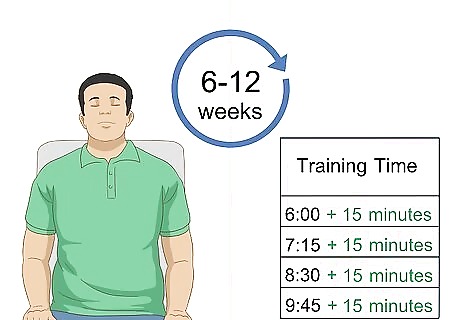
views
Interval Training

Keep a log of the specific times you urinate throughout the day. For a 24 to 48 hour period, write down what time it is when you urinate on a normal day. This will show you how long you usually wait to go to the bathroom so you have a good starting point for your training. Do this the day before you start your bladder training to get the most accurate information. For example, you might feel the urge to urinate every hour or so. If you know that, you can figure out how much longer you need to wait. Most people urinate between 4 and 7 times a day on average. If you’re going much more than that, bladder interval training is probably right for you.

Empty your bladder as soon as you wake up. This will give you a fresh start for the day so you can begin your training. As soon as you get out of bed, head to the toilet and empty your bladder completely. Your bladder usually collects a lot of urine throughout the night, so you’ll probably have to go anyway.

Try to hold your urine for 15 minutes longer than you normally would. For example, if you normally go to the bathroom every hour, try to hold it for an hour and 15 minutes. This can be tough at first, so don’t beat yourself up if you don’t quite make it. Try to avoid caffeinated drinks like coffee and tea. These make your bladder more active and can make the need to urinate more intense.

Sit down and take deep breaths when you feel the urge to go. If it’s not quite time for you to urinate yet, sit on a solid chair and hold very still. Take deep breaths in and out, and try to hold your urine in for at least an extra 5 minutes. You can also focus on relaxing your muscles or distracting yourself with something, like a book or a TV show.

Increase your interval by 15 minutes every week or so. Once you’re able to hold your urine for an extra 15 minutes, try holding it for an extra 30 minutes. As you keep going through the weeks, you’ll eventually be able to hold your urine in for longer and longer. You’re the best judge of your capabilities, so you can increase or decrease your interval times as needed.

Keep training your bladder for 6 to 12 weeks. Bladder training is a long process, and it can take a few months for your body to get used to your interval training. By the end of it, you should be able to comfortably hold your urine for 3 to 4 hours at a time. You might have good days and bad days, and that’s okay! Try not to get discouraged, and keep going to work on your urine control.
Pelvic Floor Exercises

Find your pelvic floor by stopping your urine flow midstream. Your pelvic floor muscles control your flow of urine. If your pelvic floor muscles are weak, it can be hard to hold your urine in for long periods of time. When you’re urinating, squeeze your muscles until your urine stream stops—those are your pelvic floor muscles. Try not to stop your urine midstream more than a few times. Doing this regularly over a long-term period can harm your bladder and lead to an increased risk of UTIs. If you’re having trouble finding your pelvic floor muscles, you can also squeeze your anus like you’re trying not to pass gas. Or, insert a finger into your vagina and contract your muscles.

Sit in a comfortable position. You’ll be able to do your exercises much better if you’re sitting down and feeling comfy. Choose a firm chair where you can sit up straight without distractions. If sitting down isn’t comfortable for you, you can lie down or stand up instead.

Squeeze your pelvic floor muscles 10 to 15 times. When you’re first starting out, you don’t have to hold the squeeze. Be careful not to squeeze any other muscles, and keep breathing like you normally would. If doing the exercise 10 times is too much, just do as many as you can. It’s better to go slow than too fast.

Hold the squeeze for a few seconds each when you can. As you continue your exercises, you’ll find it easier and easier to hold the squeeze. Work up to holding it for about 3 seconds before you release. It may help to breathe in as you squeeze and hold, then breathe out as you release.

Do your exercises 3 times a day. You can try scheduling your exercises for breakfast, lunch, and dinner to make it easier. The more consistent you are, the better the results will be. You’ll start to see results after a few months.

Keep doing the exercises even after you notice them working. You’ll continue to strengthen your pelvic floor muscles each time you do your exercises. If you want to, you can keep a log of each time you’ve exercised and if you’ve noticed any results yet. Pelvic floor exercises help you hold in urine and can also suppress the urge to urinate. As you continue your exercises over a few months, you may notice that you can hold your urine in for longer periods of time and you have fewer leaks throughout the day.


















Comments
0 comment